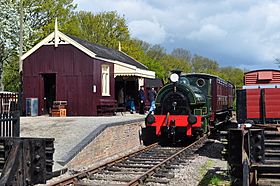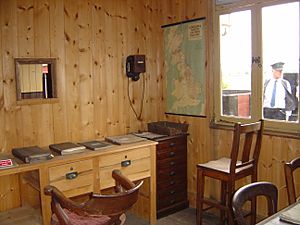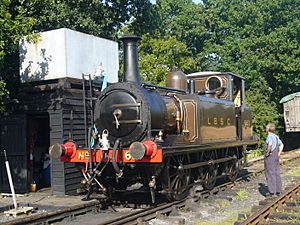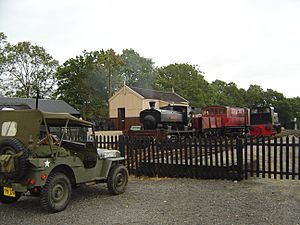Mid-Suffolk Light Railway facts for kids
Quick facts for kids Mid-Suffolk Light Railway |
|
|---|---|

Falmouth Docks in full steam.
|
|
| Locale | England |
| Terminus | Brockford |
| Commercial operations | |
| Name | Mid-Suffolk Light Railway |
| Built by | Mid-Suffolk Light Railway |
| Original gauge | 4 ft 8 1⁄2 in (1,435 mm) standard gauge |
| Preserved operations | |
| Operated by | Mid-Suffolk Light Railway |
| Stations | 2 |
| Length | 1⁄2 mile (0.8 km) |
| Preserved gauge | 4 ft 8 1⁄2 in (1,435 mm) standard gauge |
| Commercial history | |
| Opened | 1908 |
| Closed to passengers | 1952 |
| Closed | 1952 |
| Preservation history | |
| 1992 | Formation of preservation company |
The Mid-Suffolk Light Railway (MSLR) was a special kind of railway. It was built to help farmers in central Suffolk, England. This railway was called "light" because it was cheaper to build. This was allowed by a law called the Light Railways Act 1896.
People in the area were very excited about the idea. They hoped to build a 50-mile long railway network. However, not enough people bought shares to fund it. The company spent too much money for what they had.
In 1904, the railway opened 19 miles of track. It ran from Haughley to Laxfield. At first, it only carried goods. But the railway didn't make much money. This made the company's money problems even worse.
The railway company still wanted to finish the whole network. But they had huge debts and couldn't pay them back. So, in 1906, the company went bankrupt. Passenger trains started running in 1908. But not many people used them either.
In 1923, many railways in Britain joined together. The Mid-Suffolk Light Railway was still in debt. After a long argument about the money owed, it became part of the London and North Eastern Railway in 1924.
Because so few people used the line, it closed in 1952. Years later, a group of railway fans started a museum. It's at Brockford, where part of the old line was. This group is now a charity called the Mid-Suffolk Light Railway. Both the old and new railways are often called The Middy.
Contents
Early Railways in Suffolk
How Railways First Came to the Area
The very first railway in central Suffolk was the Ipswich and Bury Railway. It opened in 1846. This line connected Ipswich to Haughley and Bury St Edmunds.
Another company, the Eastern Union Railway, took over this line in 1847. They extended it to Norwich in 1848 and 1849.
Further east, the East Suffolk Railway opened in 1859. This line linked Ipswich to Yarmouth and Lowestoft. These lines were later taken over by the Eastern Counties Railway. In 1862, many railways in East Anglia joined to form the Great Eastern Railway.
The area between these main lines was mostly farmland. There wasn't much industry there.
Building a Light Railway
The Light Railways Act of 1896
The Light Railways Act 1896 was a special law. It was made to help build cheaper railways. This law made it easier to get permission to build them. It also allowed for simpler safety rules.
In 1898, a group of engineers contacted villages in Mid-Suffolk. They said a client would help pay for a light railway. This client would match money raised by local people. Many people were excited and contributed money. Nearly £1,000 was raised for legal costs.
Plans for the Middy Line
An application for a light railway order was made in May 1899. This was a request to build the railway. The plan was very ambitious. It proposed a 50-mile railway network. Supporters called it the most important light railway plan since the 1896 Act.
The railway would connect main lines. It would run from Haughley to Halesworth, about 27.5 miles. Another part would go from Bedingfield to Westerfield, 14 miles. A third section would link Debenham to Needham Market, 8 miles. The railway would use the standard track width.
At a meeting, the Great Eastern Railway (GER) supported the idea. But they had some concerns about connecting the lines. There were also many level crossings planned. It was suggested that each crossing should have a keeper. But this was too expensive.
Some parts of the plan were changed. The connection to Needham Market was dropped. This made the network 42 miles long. The Mid-Suffolk Light Railway Order 1900 was approved on April 5, 1900. The company was allowed to raise £225,000.
Building the Railway Tracks
Starting Construction
The railway directors quickly prepared for building. A company called S Pearson and Sons was hired in July 1900. But after a few months, they complained they hadn't received instructions. This was because the railway company hadn't raised enough money yet.
In November 1901, engineers found a problem near the River Blyth. They suggested changing the route there. The company asked their bank for £1,000 to pay for more surveys. This was before they had even sold shares.
The share sale prospectus was finally published in December 1901. It made the railway sound very important. S Pearson and Sons quit the job. They were frustrated by the delays. S Jackson of London was hired instead.
Important Visitors and Money Troubles
The first ground was broken on May 3, 1902, at Westerfield. The company spent a lot of money on the ceremony. Even though they had money problems, 600 guests attended a fancy lunch. The 83-year-old Duke of Cambridge performed the ceremony.
On July 22, 1902, the bank agreed to another loan of £15,000. Many more loans followed.
On September 22, 1902, Lord Kitchener, a famous general, visited Ipswich. The next day, he visited Aspall Hall. The railway line was mostly finished from Haughley to Mendlesham. Lord Kitchener rode on the line in a special wagon. He then continued by car, which was very new at the time.
In August 1903, the company announced more loans. This was because not enough people bought shares. The company wanted to open the Westerfield section first. They hoped to attract people living there to use the trains.
By the end of 1903, the company's money situation was very bad. The bank said they would not lend any more money. The directors were surprised. In April 1904, the government offered £25,000. But only if the local council gave the same amount. The council refused.
There were also problems with the Great Eastern Railway. They wanted a high rent for using their station at Haughley. The Mid-Suffolk Light Railway couldn't afford it. It took until February 1905 to agree on a route change at Halesworth. There were also arguments about steep slopes and train movements.
Opening the Railway
First Trains and Goods Service
The line between Haughley and Laxfield opened for goods trains on September 20, 1904. But much work was still needed. The first train left Haughley at 8:00 a.m. It was pulled by a locomotive named Lady Stevenson. It carried ballast wagons for the construction. It also picked up some packages on its way back.
The Mid-Suffolk Light Railway's first own locomotive arrived in November 1904. It was an 0–6–0 tank engine, numbered 1 and named Haughley. The company that built it didn't release it at first. They were worried the railway couldn't pay. More goods wagons arrived later. A second locomotive came in March 1905.
Goods stations were set up at Mendlesham, Aspall, Kenton, Horham, and Stradbroke. Later, more opened at Old Newton, Brockford, Worlingworth, and Wilby. The railway helped farmers transport cattle from the Laxfield area. This reduced the cattle traffic on the Great Eastern Railway.
Plans for Passenger Service
In January 1905, the railway planned to start passenger service. They wanted to run four trains each way between Haughley and Laxfield. On Tuesdays, Ipswich market day, they would run six trains.
However, passenger trains needed an inspection by the Board of Trade. This hadn't happened yet. Even so, a private passenger train ran in June 1905. An Ipswich history group visited churches and houses. Over a hundred members rode a Mid-Suffolk train to Kenton and back.
In 1905, the company owned two locomotives, seven carriages, and many wagons. Most of this equipment was paid for. But locomotive No. 2 was not. There were also arguments between the builder and the railway.
Financial Troubles and Inspection Failure
In March 1905, the company's chairman, Francis Seymour Stevenson, suddenly resigned. He was personally bankrupt. This, along with the builder leaving, made the company look very bad. When debts were due, the company couldn't pay. Lawsuits were filed against them.
The company sold land at Westerfield to the Great Eastern Railway. They used this money to pay some of their debts.
The Board of Trade inspection for passenger service happened on July 2, 1905. Lieutenant Colonel P. G. Von Donop found many problems. He refused to allow passenger trains to run.
In 1906, the company decided to extend the line to Cratfield. This section opened in June 1906. Sometimes, passengers were allowed to ride on the goods trains.
Problems and Passenger Service Begins
More Financial Difficulties
More debts were due in October 1906. The company had no money to pay them. So, the company went bankrupt. A receiver was appointed on October 6, 1906. A receiver is someone who manages a company's money when it's in trouble. J F R Daniel, who was 78 years old, was chosen. He had helped another railway through money problems.
In February 1907, there was a public meeting about the Halesworth route change. The company wanted to cross the Great Eastern Railway line. They also wanted to connect to the narrow-gauge Southwold Railway. The GER objected, saying it would be unfair competition. The Commissioners agreed with the GER. So, the Mid-Suffolk Light Railway couldn't build that part of the line.
Passenger Trains Finally Start
The receiver's main goal was to start passenger trains. A lot of work was done to fix the problems. Von Donop inspected the line again on September 25, 1908. He wasn't completely happy. But he approved the opening if some small things were fixed. Passenger service finally began on September 29, 1908.
Later Years and Closure
Changes and World War I
In February 1912, the section from Laxfield Mill to Cratfield closed. It wasn't making enough money. The railway directors still hoped to extend the line to Halesworth. But they were reminded that they would have to buy the line back from the receiver. This was impossible. The directors finally accepted that their big plan couldn't happen. The tracks beyond Laxfield were removed in 1914 for use in World War I. The Cratfield extension had opened in 1906 and closed in 1912. The railway, which was planned to be 50 miles, ended up being only 19 miles long.
In the summer of 1911, Sunday trains ran. But they didn't make money and were stopped.
Joining the Big Railways
After World War I, the railway needed a lot of repairs. But it didn't have enough money. The Railways Act 1921 changed British railways. Most of them joined four new big companies. This was called "the grouping." The Mid-Suffolk Light Railway was supposed to join the new London and North Eastern Railway (LNER).
But the MSLR was still bankrupt. It had huge debts of £89,794. The LNER talked with the people the MSLR owed money to. They agreed to reduce the debt to £29,960. This argument took a long time. It was finally settled on April 3, 1924. The MSLR officially became part of the LNER on July 1, 1924, but the change was dated back to January 1, 1923.
The LNER looked closely at how many passengers used the line. From 1925 to 1928, the number of tickets sold dropped. In 1930, the line only made £990. There was even a serious idea to turn the railway into a road. But it was too difficult.
World War II and Final Closure
During World War II, the passenger train service was cut. Only two trains ran each way every day. This continued until the line closed. From November 1939, the trains used the LNER platform at Haughley. The old MSLR station was only used for goods trains.
Fewer and fewer people used the line. The railway lost more and more money. So, it was decided to close it. All train services stopped on July 28, 1952. The tracks were later removed by contractors.
Railway Stations on the Middy Line
Here are the passenger stations that were on the Mid-Suffolk Light Railway:
- Haughley: Opened September 29, 1908. Closed November 1939, trains moved to the main line station.
- Mendlesham: Opened September 29, 1908. Closed July 28, 1952.
- Brockford and Wetheringsett: Opened September 29, 1908. Closed July 28, 1952.
- Aspall and Thorndon: Opened September 29, 1908. Closed July 28, 1952.
- Kenton: Opened September 29, 1908. Closed July 28, 1952.
- Worlingworth: Opened September 29, 1908. Closed July 28, 1952.
- Horham: Opened September 29, 1908. Closed July 28, 1952.
- Stradbroke: Opened September 29, 1908. Closed July 28, 1952.
- Wilby: Opened July 1909. Closed July 28, 1952.
- Laxfield: Opened September 29, 1908. Closed July 28, 1952.
The Middy Today: A Heritage Railway
Almost 40 years after the original railway closed, a group of railway fans started a new company. They wanted to bring the Middy Line back to life. They chose the site of the Brockford and Wetheringsett railway station.
The Mid-Suffolk Light Railway Society faced a big challenge. The original line was built very simply. No original Middy coaches or locomotives are still around. The old station buildings were left to rust or sold to farmers.
However, the Society has been recreating what the Middy looked like. They use restored coaches and wagons. These would have run on the Middy's bigger neighbors, like the Great Eastern Railway. The Society has collected several Great Eastern coaches. Three are now working, and others are being fixed up. The museum has also collected some original station buildings from former Middy railway stations.
In February 2017, the Society got permission to extend the line. They planned a new station called Wilby Halt. The Society also plans to eventually reopen the line as far as Aspall. They made progress on this extension during the COVID-19 pandemic. The work was done by Network Rail contractors. In April 2025, an extension to the future site of Aspall Halt was opened.
The Society also has a collection of goods wagons and old delivery vehicles. They also have items found along the railway line. Plus, there's an archive of photos and original items from the Middy's past.
The museum is open from April to the end of September. It's open on Sundays and Bank Holidays. They also have special Santa trains in December. Many Open Days feature a special event with the steam locomotive running.
The Middy in Books
Love on a Branch Line
The Mid-Suffolk Light Railway was the inspiration for a novel. It's called Love on a Branch Line by John Hadfield. The book was first published in 1959. It was later made into a television series in 1994.





